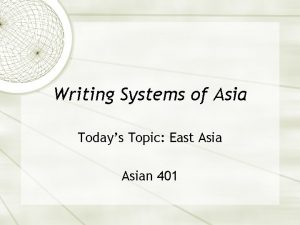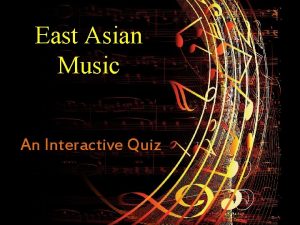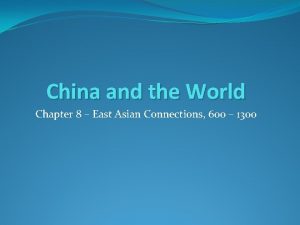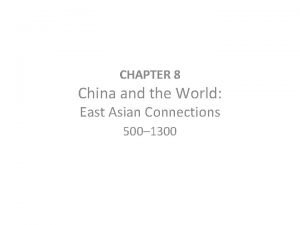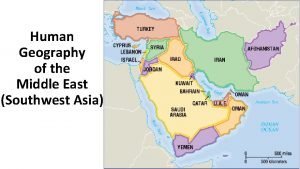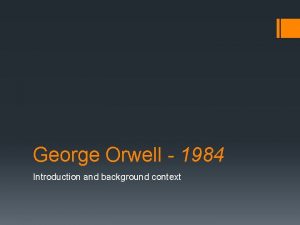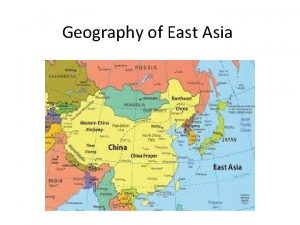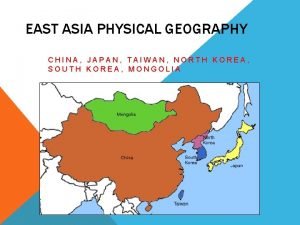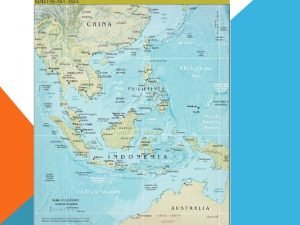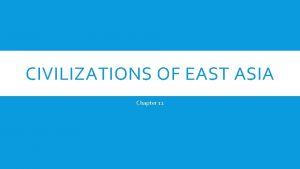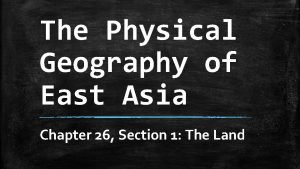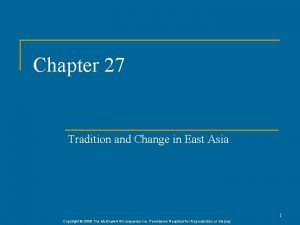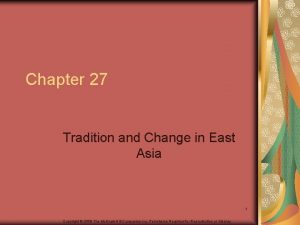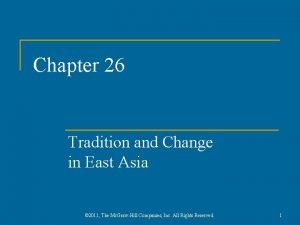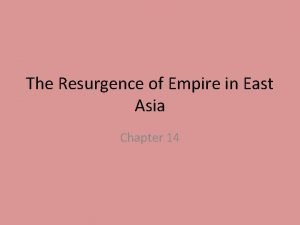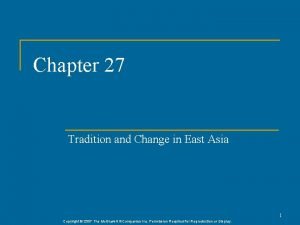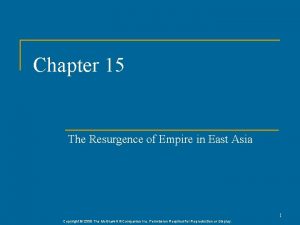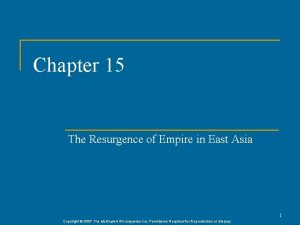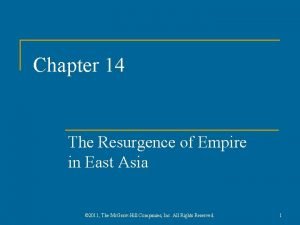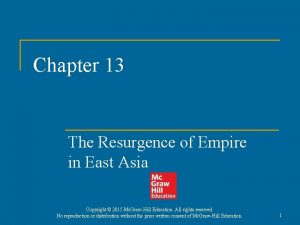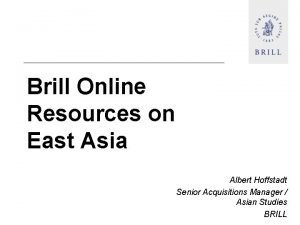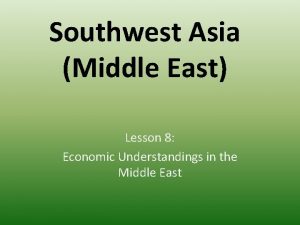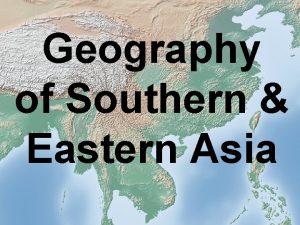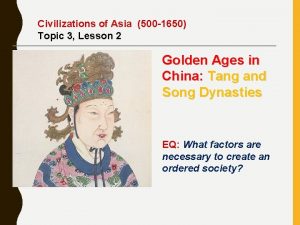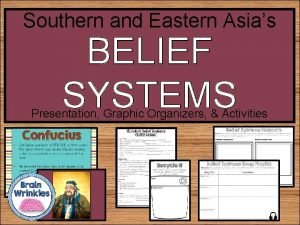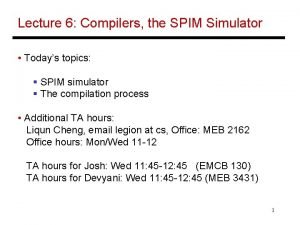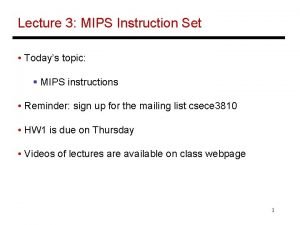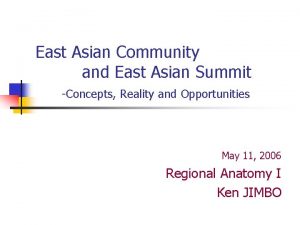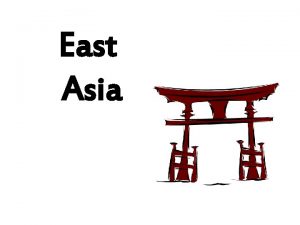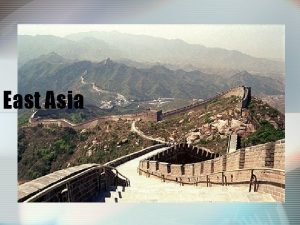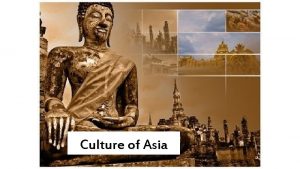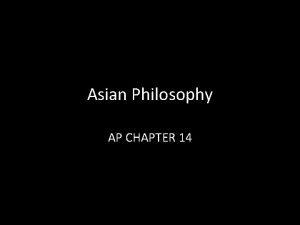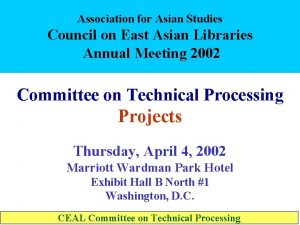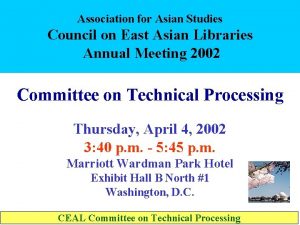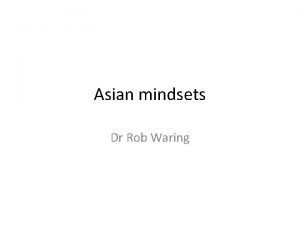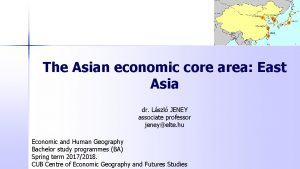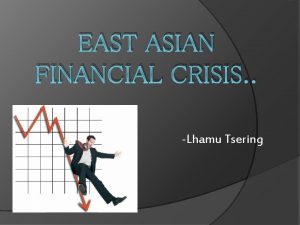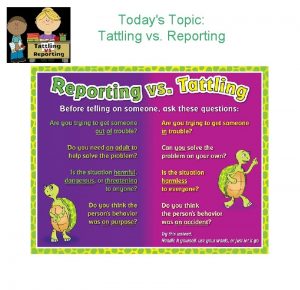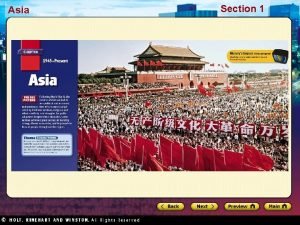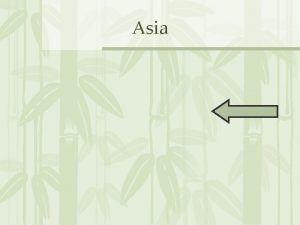Writing Systems of Asia Todays Topic East Asian















































- Slides: 47

Writing Systems of Asia Today’s Topic: East Asian 401

Chinese half-Yuan bill

Writing and Language We must clearly distinguish writing from spoken language All human societies have spoken language; all human children learn it naturally (exception: deaf community) Only some societies have writing; it must be formally learned

Writing and Language No form of writing exists independently of spoken language Writing is relatively new: invented about 5000 years ago We will look at writing from a linguistic perspective: what is its relationship to spoken language?

Writing and Language There is no inherent connection between a script and a language. One script can be used to write different languages (e. g. Roman script for English, Chinese, Japanese, Spanish). One language can be written in different scripts (e. g. Uighur, Serbo. Croatian)

Definition of Writing What is writing? How might we define it …? “The representation of spoken language through the use of visible, (potentially) permanent signs. ” Are these signs writing?

Definition of Writing No writing system represents all aspects of spoken language. For example, most writing systems don’t represent intonation very well. Some don’t represent vowel sounds. Native speakers can use context to supply information that is missing.

Origins of Writing has (we think) been invented only four times in human history: Sumerians (ca. 3200 BCE) - cuneiform Egyptians (ca. 3200 BCE) - hieroglyphs Chinese (ca. 1250 BCE) - characters Mayans (ca. 600 BCE) - hieroglyphs Your textbook describes the development process

Origins of Writing Many other writing systems have been invented But all were invented by people who already knew about the concept of writing Example: The Phoenician alphabet, which gave rise to the Hebrew, Greek, Latin and Arabic alphabets

Definitions: script: a set of signs, or graphs, which form a system that can be used for writing Examples of scripts Roman alphabet Cyrillic alphabet Arabic alphabet Chinese characters A a å are allographs of one grapheme <a>

Definitions: orthography: a writing system, i. e. a script the language-specific rules for how to use the graphs in the script to write words English and French orthographies both use the Roman script (w/modifications) Arabic and Urdu orthographies both use the Arabic script (w/modifications)

Script types Scripts can be broadly classified according to the unit of spoken language represented by each graph. Languages have sound-based units that lack inherent meaning (phonemes, syllables). Languages have meaningful units that include sound (morphemes, words).

Script types logographic: each graph writes a morpheme or a word; each graph thus represents both sound and meaning phonographic: each graph writes a sound with no inherent meaning syllabic: each graph represents a syllable alphabetic: each graph represents a phoneme

Script types other types: some phonographic scripts are neither strictly alphabetic nor syllabic, such as the “abugidas”, “alphasyllabaries”, or “akṣara-based” scripts of South India The four ex nihilo writing systems were apparently all logographic in origin

Script types The script types just described are idealized. Over time, the precise relationship between graph and speech unit can shift. (Cf. English spelling, which has become irregular over time. ) Native speakers can tolerate a high degree of ambiguity and inconsistency in a writing system.

Example 1: Tangut Empire (11 th-13 th centuries) in what is now Northwest China Invented a logographic script

Example 2: Yi A minority people of Southwest China speaking a Tibeto-Burman language Syllabic script, each of about 800 graphs represents a syllable including tone

Example 3: Tibetan alphabet invented around 7 th century, derived from Indic script

East Asian Writing: Chinese writing is logographic Each graph (“character”) represents one morpheme 人 rén [ɹən 35] ‘person’ 男 nán [nan 35] ‘male’ 的 de [tə] ‘possessive particle’ Some morphemes are free, some bound

East Asian Writing: Chinese characters do not write words! Many words have two morphemes; they are written with two characters: 男人 nánrén ‘man’ (‘male’ + ‘person’) Homophonous morphemes are written with different characters: 南 nán ‘south’ 難 nán ‘difficult’ 仁 rén ‘benevolence’

Chinese morphology Chinese is monosyllabic >99% of Chinese morphemes are one syllable Chinese is isolating Morphemes never change form Characters write morphemes; so each character writes one syllable that has an invariant pronunciation and a meaning “Chinese characters write meaningful syllables. ” Skip Chinese Character Composition

Chinese character composition Over 90% of Chinese characters are composed of graphic elements that are found in other characters Functionally, these graphic elements may be phonetic: related to the sound of the morpheme semantic: related to the meaning of the morpheme Neither phonetic nor semantic elements give precise information

Phonetic Components 方 房 紡 放 ‘square’ ‘house’ fäng fáng ‘spin’ ‘release’ fâng fàng

Phonetic Components 青 情 精 倩 ‘green’ ‘feeling’ ‘essence’ ‘pretty’ qïng qíng jïng qiàn

Semantic Components 心 情 恨 愛 ‘heart’ ‘feeling’ xïn qíng ‘hate’ ‘love’ hèn ài


East Asian Writing: Japanese had no writing when they first encountered Chinese civilization. Educated Japanese read and wrote Chinese. The Japanese language could not be written. Gradually, the Japanese learned to employ Chinese logographs as phonographs to represent the sound value of Japanese syllables.

East Asian Writing: Japanese Around the 9 th century, the Japanese invented two syllabaries by simplifying the forms of phonographically-used Chinese characters. The resulting standardized syllabaries are called kana

Japanese kana One type, hiragana, is derived from cursive forms of Chinese characters. They are rounded. The other type, katakana, is derived by taking part of a Chinese character. They are angular. Both syllabaries have graphs that represent the 45 CV syllables of Japanese, plus one additional graph for syllable-final -N.

Japanese kana Character 加 天 不 保 呂 Meaning ‘add’ ‘sky’ ‘not’ ‘guard’ ‘spine’ Japanese Pronunciation KA TEN FU HO RO Hiragana か て ふ ほ ろ Katakana カ テ フ ホ ロ Value ka te fu ho ro

Japanese writing Both hiragana and katakana are full syllabaries; either one alone could be used to write all the sounds of Japanese writing today uses three scripts: Chinese characters (kanji) Hiragana Katakana Example: 新しいジュースです. “It’s a new juice”

Japanese writing Kanji is used to write root morphemes Hiragana is used to write inflectional morphemes and grammatical words Example: hanas-emasita ‘spoke’ 話せました Suffixes indicating politeness and past tense are written in hiragana. The root ‘speak’ is represented by kanji. Writing は な せ ま し た is also acceptable.

Japanese writing Katakana is usually reserved for non-Chinese foreign loan words, onomatopeia, and visual emphasis (like italics) “It’s a new juice” 新しいジュースです. Atarasii djuusu desu new-PRES juice be

Japanese kanji One kanji can represent more than one morpheme. There are two root morphemes for ‘new’ in Japanese: the native root ataraand the borrowed Chinese morpheme shin. The Chinese character 新 can be used to write both. A Japanese reader relies on context and morphological rules to determine how to read each kanji.

Japanese writing Japanese “mixed-script” writing is one of the most complex writing systems on earth. It employs three scripts at the same time. One kanji can have anywhere from one to five or more possible pronunciations. Most have two or three. Why not do away with kanji and only use a kana syllabary? Answer is too complex for this class!

East Asian Writing: Korean As in Japan, for an ancient Korean to be literate meant reading and writing Chinese. Korean could not be easily written. In 1443 King Sejong invented the alphabet now called hangŭl Korea has a holiday celebrating the alphabet The only alphabet based on scientific principles of articulatory phonetics

Korean alphabet The shapes of the letters mimic the shape of the articulators in the vocal tract Modifications to letters indicates changes of features such as aspiration and nasalization Examples: ㄴ ㄷ ㅌ /n/ /th/ ㅅ ㅈ ㅊ /s/ /tʃh/

Korean alphabet The Korean alphabet is unusual in that the letters are not placed in a row Letters are grouped into syllable blocks, the same size and shape as a Chinese character Example: To write the word hangŭl, the letters are ㅎㅏㄴㄱㅡㄹ /h a n k ɯ l/. It is two syllables, so two blocks: 한글

Korean alphabet Korean writing is an alphabet, but also represents some features of phonemes (like aspiration and place of articulation), and syllable boundaries. It also represents morphemes! {kuk} means ‘country’. It has an allomorph /kuŋ/ that occurs before nasals.

Korean alphabet {han} ‘Korean’ + {kuk} ‘country’ = /hankuk/ ‘Korea’ {kuk} ‘country’ + {min} ‘people’ = /kuŋmin/ ‘citizen’ In Korean writing, the morpheme {kuk} is always written 국: 한국 /hankuk/ 국민 /kuŋmin/

Chinese characters in Korean Like Japanese, Korean has thousands of borrowed Chinese morphemes Historically, these words were written with Chinese characters; hangŭl was used for inflectional endings and native Korean words Over the last fifty years, the use of Chinese characters has declined considerably No longer used in North Korea Increasingly rare in South Korea


Summary: Chinese The Chinese invented Chinese characters around 1250 BCE One of only four civilizations to invent writing from scratch In Chinese, Chinese characters write monosyllabic morphemes (logographic) [Most Chinese characters contain phonetic and semantic elements]

Summary: Korean & Japanese Educated Japanese and Koreans originally used Chinese as their written medium of communication Because of their familiarity with Chinese, many Chinese words and morphemes were borrowed into spoken Korean and Japanese

Summary: Japanese In the 9 th century, the Japanese derived syllabaries (kana) from Chinese characters. There are two syllabaries: rounded hiragana and angular katakana Hiragana, katakana, and kanji are all used together in written Japanese

Summary: Korean In the 15 th century, King Sejong invented the Korean alphabet hangŭl Letter shapes are based on principles of articulatory phonetics Chinese characters are still used occasionally in South Korea to write borrowed Chinese morphemes

End
 Asian writing systems
Asian writing systems Korean music traditionally associated with the lower class
Korean music traditionally associated with the lower class South east asian ministers of education organization
South east asian ministers of education organization Chapter 8 china and the world
Chapter 8 china and the world Chapter 8 china and the world east asian connections
Chapter 8 china and the world east asian connections Which southwest asian country is the farthest east
Which southwest asian country is the farthest east Human geography of the middle east
Human geography of the middle east Oceania 1984
Oceania 1984 Geography of asia
Geography of asia Physical geography east asia
Physical geography east asia Southeast asia climate
Southeast asia climate Guided reading activity civilizations of east asia
Guided reading activity civilizations of east asia China population density
China population density Physical geography of east asia
Physical geography of east asia The commander of the german east asia squadron was
The commander of the german east asia squadron was Chapter 27 tradition and change in east asia
Chapter 27 tradition and change in east asia Chapter 27 tradition and change in east asia
Chapter 27 tradition and change in east asia Chapter 26 tradition and change in east asia
Chapter 26 tradition and change in east asia Chapter 14 the resurgence of empire in east asia
Chapter 14 the resurgence of empire in east asia Han dynasty spice chart
Han dynasty spice chart Chapter 27 tradition and change in east asia
Chapter 27 tradition and change in east asia Chapter 15 the resurgence of empire in east asia
Chapter 15 the resurgence of empire in east asia Chapter 15 the resurgence of empire in east asia
Chapter 15 the resurgence of empire in east asia Chapter 14 the resurgence of empire in east asia
Chapter 14 the resurgence of empire in east asia The resurgence of empire in east asia
The resurgence of empire in east asia East asia sushi
East asia sushi Global east asia medical center
Global east asia medical center East asia
East asia Lesson 8 middle east and south asia
Lesson 8 middle east and south asia Southern & eastern asia physical features map
Southern & eastern asia physical features map Chang'an
Chang'an Topic 3 review questions civilizations of asia answers
Topic 3 review questions civilizations of asia answers What is the horizontal movement of air called
What is the horizontal movement of air called North american
North american East is east and west is west
East is east and west is west Clincher ideas
Clincher ideas /topic/ down
/topic/ down Southern and eastern asia's belief systems answer key
Southern and eastern asia's belief systems answer key Drivers ed module 10 topic 1
Drivers ed module 10 topic 1 Topic 2 free enterprise and other economic systems
Topic 2 free enterprise and other economic systems Generations
Generations Todaysclass
Todaysclass Multiple choice comma quiz
Multiple choice comma quiz Todays worldld
Todays worldld Define radient energy
Define radient energy Todays globl
Todays globl Todays wordlw
Todays wordlw Chapter 13 marketing in today's world worksheet answers
Chapter 13 marketing in today's world worksheet answers
